In this Part we will explore the meaning of the Thirteenth Shloka of Sri Vishnu Sahasranamam.

Rudro Bahushira Babhruh Vishvayonih Suchishravah |
Amrutah SasvataSthanuh Vararoho Mahatapah ||13||
Purport:
Bhagavan brings tears of joy to his devotees. He is multi-headed with eyes, ears, hands and feet in all directions and HE supports the earth in his AdiSesha form. He is the root cause of the Universe and one who has divine ears that hear all things Pure. He is insatiable nectar to his devotees and is eternally firm. He is the Supreme Object of Attainment and He is endowed with great knowledge.
This Shloka contains the following 9 Namas:
115. Rudrah
116. Bahushirah
117. Babhruh
118. Vishvayonih
119. Suchishravah
120. Amrutah
121. SasvataSthanuh
122. Vararohah
123. Mahatapah
Now let’s examine the meaning of this Shloka in detail:
115. Rudrah
This Nama has three meanings:
a) One who brings tears of joy to his devotees;
b) One who confers the good on his devotees; and
c) One who destroys misery.
 Rodayati iti rudrah – Sri Parasara Bhattar interprets this to mean that Bhagawan brings tears of joy to His devotees. While Sri Adi Sankara explains this as ‘Samhaara kale praajaah samharan rodayati – At the time of final destruction He makes people cry.’
Rodayati iti rudrah – Sri Parasara Bhattar interprets this to mean that Bhagawan brings tears of joy to His devotees. While Sri Adi Sankara explains this as ‘Samhaara kale praajaah samharan rodayati – At the time of final destruction He makes people cry.’
The other way of interpreting this is “Rudam dadaati iti Rudrah– He confers good things” or “Ruh draavayati iti Rudrah – He eliminates devotees’ miseries.” Shiva Puraana says “RurDuhkham Duhkhahetum vaa Tad Draavayati yah Parabhuh, Rudra ityuchyate Tasmaat Shivah Paramakaaranam – He is called Rudrah because he liquidates all our sorrows and their causes.” Sri Adi Sankara further explains that ‘Rud’ means ‘good’ and ‘Ra’ means ‘one who confers’ and, hence Rudra means one who confers good.
It’s very interesting to note the Namas generally attributed to Shiva such as Rudra, Sthaanu, Eeshaana and even the Nama Shiva also appear in the Vishnu Sahasranamam. The converse is also true. In Sri Rudram we have a line saying ‘Om Namo Bhagavate Rudraaya Vishnave Mrityur me Paahi’ where Rudra is addressed as Vishnu. It goes to show the basic underlying unity of Hari and Haran.
116. BahuShirah
Bahu-Shirah means the One who is multi-headed. In Purusha Suktam Bhagavan described as “Sahasra SIrshA purushah sahasrAkshah sahasra pAt meaning HE is the Purusha with thousand heads, thousand eyes and thousand feet… In the Bhagavad GItA Chapter 11 Verse 11, Sanjaya says -SarvAScarya mayam devam anantam viSvatO mukham –
Sanjaya says that Arjuna witnessed the Viraat rUpa of Bhagawan which had countless faces looking in all directions.
In the Bhagavad Gita Chapter 11 Verse 16, Arjuna says:
‘Aneka Bahoodara Vaktra Netram Pashyaami tvaam Sarvato nantaroopam
Na antam na madhyam na punasvatim Pashyami Vishveshwara Vishvarupa
Meaning: I see your endless form everywhere with countless hands, heads, stomachs and eyes. I see you with no end, no middle and no beginning’.
 Sri Parasara Bhattar has interpreted the Nama as referring to the form of Bhagavan as Ananta, in which form He has many faces and over a thousand hoods.
Sri Parasara Bhattar has interpreted the Nama as referring to the form of Bhagavan as Ananta, in which form He has many faces and over a thousand hoods.
Again in Chapter 13, we have “sarvatah paaNi paadam tat sarvato’kshi SirO mukham – The Pure svarupa has hands and legs everywhere, has eyes, heads, and mouths everywhere”.
117. Babhruh
 Sri Adi Sankara interprets this as ‘Bibharti lOkAn iti babhruh – The one who supports the world.’
Sri Adi Sankara interprets this as ‘Bibharti lOkAn iti babhruh – The one who supports the world.’
He as AdiSesha supports the earth. He is also the supporter of the Earth as Adi Kurma, Adi Varaha, etc.
118. Vishva-yonih
 The Nama Vishvayonih has two meanings:
The Nama Vishvayonih has two meanings:
a) He is The Cause of this World; and
b) He is the One who unites His devotees with Himself.
Yoni means ‘Cause’, since He is the cause of this world He is called Visvayoni. In The 89th nama – Visvareta – we saw that He is the seed from which the world originated. This Nama says that He is also the place where the seed develops into its full blossom. Yoni means womb, and He is the seed, the womb, the Sustainer after the birth of the world, the one who impartially observes as the Kshetrajna or skilfully cultivates.
 The word Yoni is derived from the word yu which means – to unite (yu miSraNE). Thus Yoni can refer to Bhagavan’s act of uniting His devotees with Him.
The word Yoni is derived from the word yu which means – to unite (yu miSraNE). Thus Yoni can refer to Bhagavan’s act of uniting His devotees with Him.
When Hanuman came and confirmed that he had sighted Sita, Lord Rama was so happy that he gave him a tight hug!
Hanuman was ecstatic!
The Story of Thiruppaan Azhwar
Thiruppaan was found in a paddy field in Woraiyur by a couple from the ‘Paanar’ community. The childless pair cherished his arrival and brought him up with much love and care. Paanars’ are a community of musicians and traditional song makers who are capable of moving their audiences to states of ecstasy and bliss.
 Thiruppaan is believed to be an avatar from Vishnu’s chest known as Srivatsam (legend has it that all azhwars are avatars of some part of Vishnu).
Thiruppaan is believed to be an avatar from Vishnu’s chest known as Srivatsam (legend has it that all azhwars are avatars of some part of Vishnu).
Being a divine child, his instincts were heavenly and he grew as a man uninterested in all the glamour of the world. Having a veena in his hand, he was always seen singing glories of Vishnu. He was soon famous in and around villages of Southern India.
 His skills as a bhakti (divine) musician and his abilities to express that invoked bhakti amongst his listeners, drew audiences from afar. He was soon to be known as “Paanar Perumal”.
His skills as a bhakti (divine) musician and his abilities to express that invoked bhakti amongst his listeners, drew audiences from afar. He was soon to be known as “Paanar Perumal”.
The Paanar Community was considered as outcastes. One of the strictures on them was that they were not allowed to use the shores of Cauvery River, considered sacred and pure by the higher caste people of the region. Following this stricture, Paanar Perumal did not come near the Cauvery River, but mostly stood alongside its banks facing the Srirangam temple and sang in praises of Lord Ranganatha.
One day, a Sage by the name Loka Saranga came to the River Cauvery for drawing water for the temple. Paanar was in deep devotion and was unaware of his surroundings that he missed the voice of Loka Saranga asking him to move away. The sage threw a small stone in his direction to wake him, but the stone accidentally hit the forehead of Paanar and he started to bleed and he retired quietly.
Unaware of the injury caused to Panaar, the Sage returned to the temple. He was taken aback on seeing blood oozing out from the forehead of the idol of Lord Ranganatha. That very night, the Lord appeared in the dream of Loka Saranga and commanded him to bring Paanar to the temple on his shoulders the following morning.
Accordingly, Loka Saranga requested Paanar to come to the temple on his shoulders. But Paanar, referring to his lowly birth, declined to go along.
When he was told of Vishnu’s command, Paanar agreed. When they reached the sanctum, Paanar experienced the bliss of Lord Ranganatha and composed the AmalanAdhipiraan comprising of 10 Pasurams or verses describing the beauty of the Lord Ranganatha from the Lord’s Lotus feet to his divine head and ultimately laid his life at the feet of the deity.
The first Pasuram is describing Arangan’s feet:
NeeL madhil Arangathamman thirukkamalapaadham
vandhu en Kannin ullana okkinrathe.
Meaning: He is the Lord of Arangam surrounded by lofty walls. O, his auspicious Lotus feet have come to stay in my eyes.
He then proceeded to describe the whole body of the Lord and sang a total of ten Pasurams (or hymns) which described in detail the beauty of the Lord Ranganatha from his Lotus feet to his Divine head.
His final Pasuram read as:
Kondal vannanaik kovalanay venney Unda vayan en ullam kavarndhaanai
Andarkon aNi arangan en amudhinaik Kanda kangal marronrinaik kanave
Meaning: The dark-hued Lord is the One who came as a cowherd lad and stole butter. He is the Lord of Gods and of Arangam also. He has stolen my heart. After seeing my Lord and experiencing ambrosial delight, my eyes will see nothing else.
And finally after completing the verses, Thiruppaan Azhwar fell down and laid his life at the Lord’s feet and attained liberation. He became a part of the Lord along with his mortal sheath.
His principal purport in them is: “Perumal is the principal supreme entity and our aims and aspirations should be to attain Him through total surrender to him signified by our placing all of ourselves at his lotus feet”.
Without the Lord’s will, no one can be united with Him. He is Visvayoni because He unites His devotees with Himself.
119. Suci-Shravah
This Nama has three meanings:
a) One who listens to words which are pure;
b) One whose names are worthy of being heard; and
c) One who has beautiful and divine ears.
SruNoti iti Suci-SravAh – One who listens to words that are pure. Sri Bhattar gives the following reference from the MahAbhArata –
“SucIni SrAvaNIyAni SriNomi iha dhananjaya |
na ca pApAni grihNAmi tato’ham vai SuciSravAh || (MB Santi parva 344.61)
“O Dhananjaya! I listen here to all that is pure and agreeable to hear. I do not heed to what is sinful. Therefore I am known as Suci-Shravaah”.
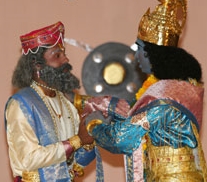 In this context, Sri Parasara Bhattar points out the incident where Krishna kept listening to the words of Vidura, which were full of dharma, and the night passed away for Krishna unnoticed –
In this context, Sri Parasara Bhattar points out the incident where Krishna kept listening to the words of Vidura, which were full of dharma, and the night passed away for Krishna unnoticed –
“dharmyA ramyASca arthavatIh vicitrArtha padAksharAh
SriNvanto vividhA vAcah vidurasya mahAtmanah |
akAmasyaiva krishNasya sA vyatIyAya SarvarI || (MB Udyoga 93.2)
b) Sri Adi Sankara gives the following interpretation – SucIni Sravamsi nAmAni SravaNI yaanyasyeti Suci-Sravaah – The One whose names and glories are very holy and purifying to hear; and
c) The word Sravas also means ear. Swami Chinmayananda interprets this Nama as meaning the One who has divine ears – He is the Hearer of all ears.
120. Amrutah
Amrut means nectar and the Bhagvan is the the unsatiating nectar to His devotees. He is also Amrita or nectar to his devotees giving joy and sustenance to them.
It is said of Valmiki that – “Yah Piban satatam Rama Charitaamrita Saagaram Atriptas tam Munim Vande Praachetasam Akalmasham – Salutations to Sage Valmiki who is never satiated even after constantly drinking in the Amrita of Ramakatha’. The devotees never get satiated by doing service to Bhagavan, and He is limitlessly sweet to the devotees.
Another meaning for Amrutah is that He is immortal. na vidyate mritam maraNam asya iti amrutah – He has no decay or death. The sruti says He is non-decaying and Immortal – ajarah amarah – (Brihadaranyaka Upanishad 4.4.25).
Swami Chinmayananda says that He is Amrutah because He can cure the disease of ignorance in His devotees.
121. Sasvata-Sthanuh
This Nama has appeared earlier in two parts as Sasvata and Sthanu separately as the 57th and 28th Namas. Sthanuh was earlier interpreted as the One who is firm in blessing His devotees, and Sasvata was interpreted as the One who is Eternal because of His unceasing act of creation, sustenance and destruction. Sri Parasara Bhattar gives this Nama the meaning ‘Eternal and Steady’. Unlike the nectar for which the Devas and Asuras churned the Ocean, He is Eternal because he cannot be taken away from those who enjoy Him. Sri Adi Sankara gives the meaning that He is “Eternally Firm”.
Sri Radhakrishna Sastri gives the interpretation that He is Sasvata because He has no beginning or end, and Sthanu because He does not age or decay.
122. Vararohah
The Nama Vararohah has two meanings:
a) One who is the ‘Supreme Object of Attainment’;
b) One who is of ‘Excellent Ascent’.
Varam means Supreme and Arohanam means ascent. Sri Parasara Bhattar’s interpretation is that He is the Supreme object of attainment and all other objects are inferior. Sri Adi Sankara gives the meaning that He is of ‘Excellent Ascent’.
Sri Radhakrishna Sastri suggests that Bhagavan is Vararohah because He is reclining on AdiSesha, the high paryanka.
Sri Parasara Bhattar interprets the first 122 Namas as describing the ‘Para’ form of Vasudeva, which is not conditioned by any limiting adjuncts and is endowed with the six qualities of Gnana, Balaa, Aishvarya, Veerya, Shakti and Tejas.
This is the object of attainment of the released souls. The transcendental nature (paratva) of Bhagavan has been spoken of mostly by the names ending with the above nama – Vararoha.
Sri Parasara Bhattar also interprets the contents of the first 122 Namas as the response from Bhishma to Yudhistra for the first two of the six questions he posed –
1) kim ekam daivatam loke? Who is the Supreme God;
2) kim vApi ekam parAyaNam? What is the highest goal in life?
Vasudeva can be taken as having been included in the ‘Para’ form. The ‘Vyuha’ forms are in charge of the work of Creation, Sustenance, and Destruction; they propound the Sastras, explain their significance, and give the fruits in accordance with the rules laid down therein; they also teach the method of meditation and worship of Bhagavan. The six qualities of the Para roopa are distributed amongst the four Vyuhas (Vasudeva, Samkarshana, Pradyumna and Aniruddha) and each has its own form and duties. They are the means for the attainment of salvation. The Samkarshana form is associated with knowledge and strength. Starting with the next nAma, the Samkarshana form – the second in the Vyuhas – will be covered.
123. Mahatapah
Mahatapah means the One who is endowed with great knowledge. Tapas generally means penance and it also means Knowledge. Supreme penance leads to ultimate knowledge and hence the two are synonymous in essence.
In this context Sri Adi Sankara interprets this Nama as ‘Mahat srijya vishayam tapo jnaanam asya iti Mahaatapaah – He has the Supreme knowledge of creation hence he is Mahatapah’.
This is also reflected in the Mundaka Upanishad which says ‘Yasya Jnaanamayam Tapah – Whose tapas is the nature of knowledge.
IN SUMMARY
Rudro Bahushira Babhruh Vishvayonih Suchishravah |
Amrutah SasvataSthanuh Vararoho Mahatapah ||13||
 Bhagavan brings tears of joy to his devotees, hence He is Rudrah. He is multi-headed with eyes, ears, hands and feet in all directions, so He is Bahushirah. He supports the earth in his AdiSesha form, hence He is Babhruh.
Bhagavan brings tears of joy to his devotees, hence He is Rudrah. He is multi-headed with eyes, ears, hands and feet in all directions, so He is Bahushirah. He supports the earth in his AdiSesha form, hence He is Babhruh.
He is the root cause of the Universe, so He is Vishvayonih. He has divine ears that hear all things Pure, hence He is Suchishravah.
He is insatiating nectar to his devotees, hence Amrutah. He is eternal with no beginning or end and has no decay, so He is SasvataSthanuh.
HE is the Supreme Object of Attainment, so He is Vararohah. He is endowed with great knowledge and hence He is called Mahatapah.
A link to the audio visual commentary on the 13th Shloka on YouTube:
https://www.youtube.com/watch?v=lVTbGKsQL0o&list=UUH6BZX9cIltjvipD3JRMDPg
Here’s an audio commentary on the 13th Shloka:
https://soundcloud.com/sridhar-r-aiyangar/sri-vishnu-sahasranamam-shloka-13
OM NAMO NARAYANAAYA
HARI OM TAT SAT
The Vishnu Sahasranamam series is authored with the help of my friend Shri Balaji.




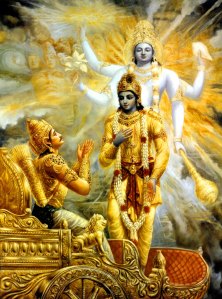





























 In the Ocean, Varaha encounters Hiranyaksha, who obstructs his path and challenges him for a duel.
In the Ocean, Varaha encounters Hiranyaksha, who obstructs his path and challenges him for a duel.




















 A person who uses the bird Garuda as his carrier. In Sri Adi Sankara’s words this is explained as ‘Vina Garudena Pakshinaa Kramaat – He moves around on the bird Garuda’. ‘Vi’ refers to the King of birds, Garuda; and ‘Krama’ refers to His Sanchara or flight on the Garuda around the World.
A person who uses the bird Garuda as his carrier. In Sri Adi Sankara’s words this is explained as ‘Vina Garudena Pakshinaa Kramaat – He moves around on the bird Garuda’. ‘Vi’ refers to the King of birds, Garuda; and ‘Krama’ refers to His Sanchara or flight on the Garuda around the World.













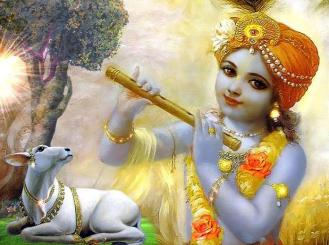

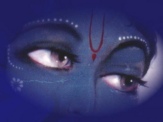
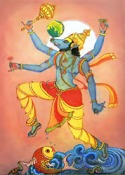
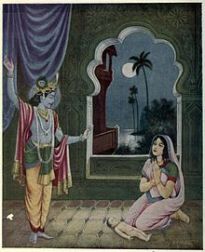
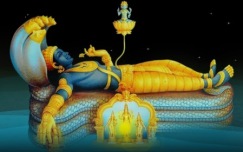




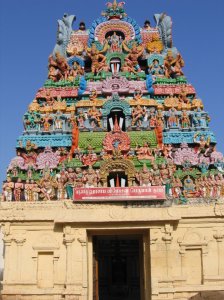



















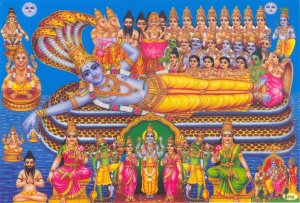













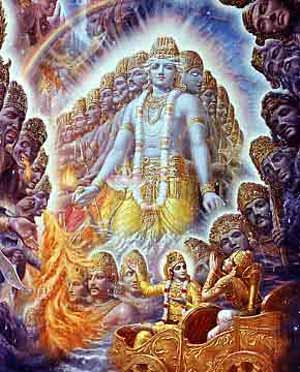












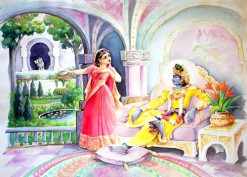

 She finally swallowed her pride and appealed to the devout Rukmini. Rukmini prayed to her Lord and put a single leaf of the sacred Tulsi (Thulasi or Tulasi) on the weighing scale (tula). Lo and behold, the scales tilted and came into balance at once and even after removing all the jewels, the scales remained even with the Tulsi leaf on the other side.
She finally swallowed her pride and appealed to the devout Rukmini. Rukmini prayed to her Lord and put a single leaf of the sacred Tulsi (Thulasi or Tulasi) on the weighing scale (tula). Lo and behold, the scales tilted and came into balance at once and even after removing all the jewels, the scales remained even with the Tulsi leaf on the other side.



















 arishi Bhrigu decided to test Lord Brahma first. As Maharishi reached Brahmaloka, he was dismayed at Brahma for not taking notice of him. Angered by this insult, Maharishi Bhrigu cursed Lord Brahma that no one will worship Brahma in Kaliyug. To this day, there are very few temples devoted to Lord Brahma (with the notable exception being the Brahma Temple at Pushkar in Rajasthan).
arishi Bhrigu decided to test Lord Brahma first. As Maharishi reached Brahmaloka, he was dismayed at Brahma for not taking notice of him. Angered by this insult, Maharishi Bhrigu cursed Lord Brahma that no one will worship Brahma in Kaliyug. To this day, there are very few temples devoted to Lord Brahma (with the notable exception being the Brahma Temple at Pushkar in Rajasthan).








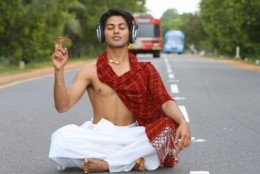














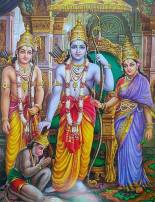





 The disciple replied “Revered Sir, I brought Lalita Sahasranamam every time but I was intercepted by a beautiful little girl on the way who snatched it from me and gave this instead each time”. Sankara was intrigued and looked around for the girl but there was no trace of her. He realised that Goddess Lalita wanted him to write commentary on the Sahasranamam of her brother Vishnu first and so, he embarked on the divine task. After completing the commentary on Vishnu Sahasranamam he wrote many other Bhashyams such as Brahma Sutra and other original compositions like SoundaryaLahari but he was never able to return to Lalita Sahasranamam.
The disciple replied “Revered Sir, I brought Lalita Sahasranamam every time but I was intercepted by a beautiful little girl on the way who snatched it from me and gave this instead each time”. Sankara was intrigued and looked around for the girl but there was no trace of her. He realised that Goddess Lalita wanted him to write commentary on the Sahasranamam of her brother Vishnu first and so, he embarked on the divine task. After completing the commentary on Vishnu Sahasranamam he wrote many other Bhashyams such as Brahma Sutra and other original compositions like SoundaryaLahari but he was never able to return to Lalita Sahasranamam.


 According to this, all Vedas have three levels of meanings. MahaBharata, also known as the fifth Veda, has ten different levels of meanings. But Vishnu Sahasranamam has hundred different meanings for each Nama! Apart from the meaning there is also the positive vibration from the chanting of each Nama. So even if the recitation is done without knowing the meaning it is still beneficial but if it is done with full understanding of the import of the meanings, it is sheer bliss.
According to this, all Vedas have three levels of meanings. MahaBharata, also known as the fifth Veda, has ten different levels of meanings. But Vishnu Sahasranamam has hundred different meanings for each Nama! Apart from the meaning there is also the positive vibration from the chanting of each Nama. So even if the recitation is done without knowing the meaning it is still beneficial but if it is done with full understanding of the import of the meanings, it is sheer bliss.

 Even after listening patiently to a lot of guidance from Bhishma, Yudhishtra felt that he had not gained sufficient understanding to his key questions on how to achieve perfect happiness and salvation. He wanted to learn from Bhishma the path to Moksha or liberation from the cycle of birth and death. Therefore he posed six specific questions relating to Bhishma on how to attain ultimate happiness. These questions are contained in two shlokas starting with “kim ekam daivatam loke” in the Poorvabhaga or the introductory part of the Vishnu Sahasranama Stotram.
Even after listening patiently to a lot of guidance from Bhishma, Yudhishtra felt that he had not gained sufficient understanding to his key questions on how to achieve perfect happiness and salvation. He wanted to learn from Bhishma the path to Moksha or liberation from the cycle of birth and death. Therefore he posed six specific questions relating to Bhishma on how to attain ultimate happiness. These questions are contained in two shlokas starting with “kim ekam daivatam loke” in the Poorvabhaga or the introductory part of the Vishnu Sahasranama Stotram.